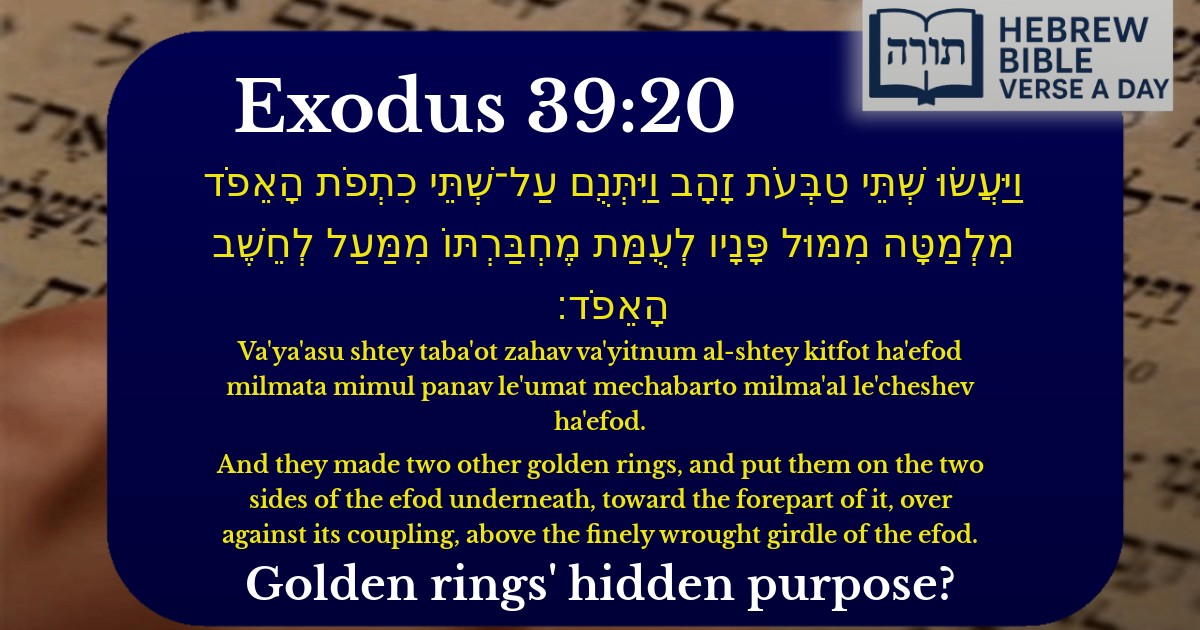Frequently Asked Questions
Q: What is the 'efod' mentioned in Exodus 39:20?
A: The 'efod' was a special garment worn by the Kohen Gadol (High Priest) during service in the Mishkan (Tabernacle). According to Rashi, it was like an apron worn on the back, made of fine linen and colorful threads, with gold and precious stones. It was an essential part of the priestly garments described in the Torah.
Q: Why were golden rings attached to the efod?
A: The golden rings on the efod served a practical purpose—they helped secure the Choshen (breastplate) to the efod. The Torah (Exodus 28:28) explains that the rings connected the breastplate to the efod with chains, ensuring it stayed in place while the Kohen Gadol performed his duties. This detail highlights the precision required in fulfilling mitzvot (commandments).
Q: What can we learn from the detailed description of the priestly garments?
A: The detailed instructions teach us the importance of hiddur mitzvah (beautifying commandments). The Rambam (Hilchot Klei HaMikdash 8-9) explains that every detail in the priestly garments had spiritual significance, showing that serving Hashem requires care, reverence, and attention to detail. This applies today in how we perform mitzvot with excellence.
Q: Why were the rings placed specifically 'above the girdle' of the efod?
A: Rashi (on Exodus 28:27) explains that the rings were positioned above the 'cheshev' (girdle) to ensure stability—preventing the breastplate from moving or dangling. This placement reflects the wisdom in the Torah's design, where even small details contribute to the proper functioning of sacred objects.
Q: How does this verse connect to the broader theme of the Mishkan's construction?
A: This verse is part of the meticulous account of building the Mishkan, emphasizing that every detail was carried out exactly as Hashem commanded (Exodus 39:42-43). The Talmud (Berachot 55a) teaches that the Mishkan’s construction mirrors the creation of the world—both were done with divine wisdom and precision, showing that holiness is found in following Torah instructions carefully.


Explanation of the Golden Rings on the Efod
The verse describes the placement of two golden rings on the efod, the priestly garment worn by the Kohen Gadol (High Priest). According to Rashi (Exodus 28:26), these rings were positioned on the lower part of the efod, near its front, opposite the joining seam above the ḥeshev (the woven band). Their purpose was to secure the ḥoshen (breastplate) to the efod, ensuring it remained firmly in place during service in the Mishkan (Tabernacle).
Structural and Symbolic Significance
The Rambam (Hilchot Klei HaMikdash 9:9) explains that the precise placement of these rings was essential for the proper functioning of the priestly garments. The rings connected the ḥoshen to the efod, symbolizing the inseparable bond between divine judgment (ḥoshen) and divine mercy (efod). The Talmud (Yoma 72a) further elaborates that the golden rings signify the unity of the Jewish people, as the ḥoshen contained the names of the twelve tribes, bound together through the efod.
Midrashic Insights
Practical Halachic Implications
The Shulchan Aruch (Orach Chayim 154) draws a parallel between the meticulous craftsmanship of the efod and the care required in preparing sacred objects today, such as Torah scrolls and synagogue adornments. The precision in attaching the rings teaches that even seemingly minor details in avodat Hashem (divine service) carry profound significance.